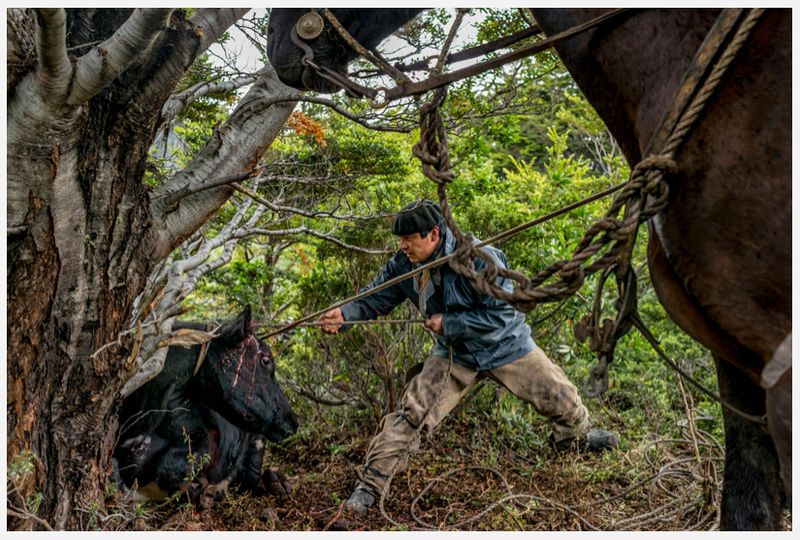 Tomás Munita, Jorge Vidal ties up a cow the bagualeros caught a couple of days earlier on Antonio Varas Peninsula in Chilean Patagonia.
Tomás Munita, Jorge Vidal ties up a cow the bagualeros caught a couple of days earlier on Antonio Varas Peninsula in Chilean Patagonia.
-
"It’s always fun to work with photographers on their first story for National Geographic because they’re usually surprised by the resources and support we can provide and by how much of a voice we give them in contributing to their story."
—Elizabeth Krist
Senior Photo Editor
National Geographic
Here's Elizabeth's article at Proof. If you watch the video, try to imagine working in those conditions. I was glad I don't have to!
Here are the Patagonia bagualeros pictures at Tomás's website (the pictures unfortunately are way oversharpened for web resolution, but try to look past that...).
Chilean Tomás Munita, born in 1975, is an independent documentary photographer interested in social and environmental issues. He's based in Santiago.
Mike
Original contents copyright 2014 by Michael C. Johnston and/or the bylined author. All Rights Reserved. Links in this post may be to our affiliates; sales through affiliate links may benefit this site.
(To see all the comments, click on the "Comments" link below.)
Featured Comments from:
James Sinks: "The post-processing looks like the clarity is pushed and then a large radius high pass filter is applied. Nice colors (a bit pumped...but still nice), nice compositions, and interesting subjects, but that processing really grates."



The photo essay looks like it might illustrate a Hemingway novel. Perhaps a "not for the squeamish" warning would help some folks. Beautiful shots, and I didn't mind the sharpening though I did see artifacts of some sort.
Posted by: John Krumm | Thursday, 04 December 2014 at 08:39 PM
Any information about how he post processes his images?
Posted by: Morgan | Thursday, 04 December 2014 at 09:05 PM
Hmm. Oversaturated too. The subject is interesting, and I really like the way he covered it. Excellent framing and composition. Great timing on the shots, and it seems nicely edited. But ouch, the processing does hurt a bit.
Posted by: Ed Hawco | Thursday, 04 December 2014 at 10:26 PM
... "not for the squeamish" indeed!
I did not spend much time looking at the work once I realized it involves the torture and mutilation of animals. I guess this is for cowboys and butchers; certainly not animal lovers or vegetarians.
Posted by: Darlene | Thursday, 04 December 2014 at 11:26 PM
I haven't seen the print edition but I'm surprised that even online, NG would accept the heavy-handed post-processing obvious on some of these. Ah well, I guess tastes are changing . . . .
[Note that the "overcooked" JPEGs were at the photographer's own website, not NG's.
I have no basis for saying this except as a guess, but it looks like the files might have been sharpened for much larger output (large prints perhaps) and then simply resized for the web from there. It just "feels" to me like lack of attentiveness from someone not used to thinking of the Web as an important venue for publication, rather than a deliberate artistic choice. As I say, that's just a guess. --Mike]
Posted by: JK | Friday, 05 December 2014 at 12:28 AM
Oh, the now city-bound, city-softened me would still have love working under those conditions, though I ain't too fond of po'd bulls.
The photos on his site are over-cooked by traditional standards, but that sort of thing seems popular nowadays. One can never get too much clarity---or contrast in the case of black and white. They'll look much better when processed for print, I'd say.
Posted by: D. Hufford. | Friday, 05 December 2014 at 01:39 AM
Definitely way too much clarity/dynamic contrast in majority of those photos.
Posted by: Søren Kristiansen | Friday, 05 December 2014 at 04:49 AM
I was a bit distracted from the content by the post-processing which seemed a bit HDR-like in some pictures. Beyond that, though, it looks a cruel and harsh life those guys lead in that astonishing environment.
Posted by: Patrick Dodds | Friday, 05 December 2014 at 05:28 AM
All that hard work and then he screws everything up with hdr horror. I hope he saved the raw files.
I wish he had gone there with a Mamiya 7
Posted by: Marcel | Friday, 05 December 2014 at 07:01 AM
For context, check out the article in National Geographic. I found the article more interesting than the photos. And although the photos are interesting in their own way, they made a lot more sense when used to illustrate the article.
Posted by: Ken | Friday, 05 December 2014 at 08:51 AM
John Krumm...EXACTLY my thoughts! I couldn't help thinking that I was paging through a photo-representation of scenes from For Whom The Bell Tolls (sans the cows, of course).
Posted by: Ben Shugart | Friday, 05 December 2014 at 09:02 AM
I agree that the processing is a little heavy handed. Maybe they'll appear differently in print? Not sure about that though.
That aside, I absolutely love the images. And watching the short video... I kind of wished it lasted an hour. Very interesting. Something kind of majestic about it all.
Posted by: BH | Friday, 05 December 2014 at 09:03 AM
Then there's proof of other things elsewhere.
Through Steve Winter’s Lens, Big Cats Step Into the Limelight: http://proof.nationalgeographic.com/2014/12/03/through-steve-winters-lens-big-cats-step-into-the-limelight/
Posted by: Dave Sailer | Friday, 05 December 2014 at 04:31 PM